Type 1 diabetes is diagnosed when there is no production of insulin; called insulin deficiency. Type 2 diabetes has a component of insulin deficiency but is mostly concerned with insulin resistance. Insulin resistance is the inability to utilize insulin that is produced and available to you. Reasons for insulin resistance are due to your family history/genetics as well as your age, weight and life style. Type 1 diabetes will require multiple daily injections of insulin or use of an insulin pump. Type 2 diabetes will usually be treated with oral diabetes medications or other injectables. People with type 2 diabetes may eventually need insulin injections as their disease progresses.
Let’s review the many kinds of insulin which are now available for blood sugar control and are prescribed by your physician. The types of insulin differ in:
- Onset: time that it takes to kick in.
- Peak: time it is most effective.
- Duration: how long the effects last.
Insulin has different forms of delivery systems. Included are syringes with an insulin bottle, an insulin pen, an insulin jet injector or delivery using an insulin pump. You and your physician will decide which delivery system is best for you depending on the cost, your insurance coverage and your present lifestyle. Insulin can be dispensed in single kinds or pre-mixed.
Single kinds of insulin:
- Rapid acting- These include Novo log, Humalog or Aphrida. These are the newer kinds which act the quickest and wear off the soonest. They allow you to be flexible with your mealtimes. They are injected 10 minutes prior to the meal to help control after meal blood sugars. They are considered bolus insulin’s. This insulin should be clear. Onset: 5-15 minutes. Peak: 30 min-2 hrs. Duration: 4-5 hrs.
- Short acting- This insulin includes all brands of R insulin’s. It works fast but not as fast as rapid acting. It is taken 20-30 minute prior to a meal. Meal time must be pre planned before taking this insulin for fear of hypoglycemia. This insulin should be clear. Onset-30-60 minutes. Peak-2-4 hrs. Duration 6-8 hrs.
- Intermediate acting- This insulin includes all brands of NPH. It takes a while to act but stays in the body longer. This insulin should be cloudy with no crystals, clumps or sediment on the bottom. Onset: 1-2 hrs. Peak: 4-12 hrs. Duration: 16-24 hrs.
- Long acting insulin- This insulin is called Lantus or Levemir. It has a flat line property and should be clear. This insulin should never be mixed with another type of insulin. Onset: 1-2 hrs. Peak: none. Duration: 16-24 hours. This insulin can be prescribed alone as a basal insulin along with oral medications or when taking rapid acting insulin as well.
Certain insulin’s are used in pre-mixed solutions to make life easier when you have poor vision, arthritis or other hand mobility issues as well as for time and convenience. A popular pre-mixed insulin is 70/30. This means 70% is intermediate insulin and 30% is regular insulin. When taking this insulin make sure to mix the insulin by gently rolling, tilting or tipping but never shake; this assures you that the insulin’s are mixed. 70/30 insulin should appear cloudy with no clumps or crystals or sediment. There are other pre- mixed insulin’s in combination of 50/50, and 75/25 containing NPH and regular insulin.
It is important to be aware that insulin may cause hypoglycemia with symptoms of shaking, sweating, dizziness, hunger, fast heart beat or feeling weak or faint. Be prepared by carrying glucose tablets which should be chewed when blood sugars reach 70 or less. Consider carrying a snack of protein and carbohydrate as well such as cheese or peanut butter and crackers. Insulin may cause weight gain; the reason is more glucose is now entering the cells instead of being lost in your urine. The excess glucose that is not used by the cells is stored as fat. Remember to change the insulin site with each injection and always change the needle. The primary site should be in the abdomen since it absorbs the insulin the best. Rotate around the abdomen and leave about 2 inches around away from the navel. Other injection sites include the upper outer thigh and the back of the upper arms. Inject into the subcutaneous fat not the muscle. Wash your hands, clean the skin site with alcohol prior to the injection, let it dry, inject and always dispose of needles correctly in a biohazard container.
Make sure you are instructed on insulin administration. Your health care provider or diabetes management program will be able to assist you for complete directions. Read the information given in the paper work and pamphlets to gain more information. Avoid extreme temperatures and never freeze your insulin. Do not allow insulin to be in direct sunlight or extreme heat.






Leave A Comment